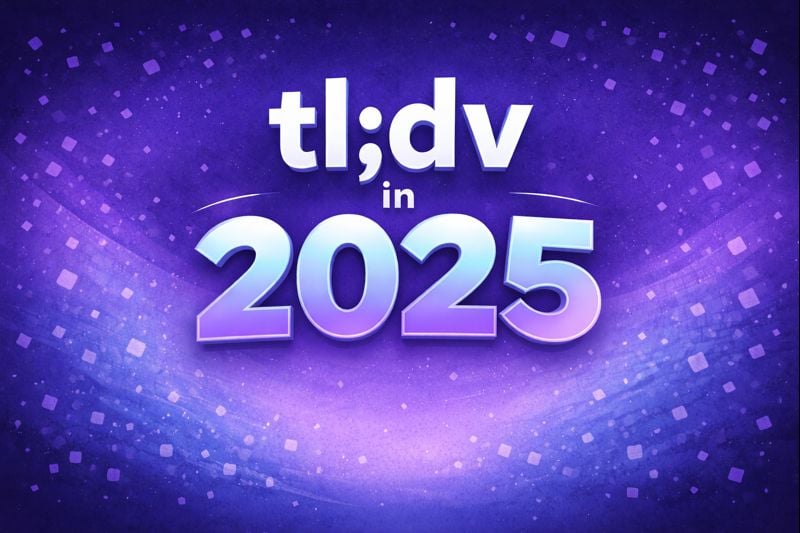If you are looking for the ultimate guide to remote onboarding best practices then pull up a chair, you have come to the right place. From tips on how to make the onboarding process as smooth as possible, to little details that are sure to impress the new recruit – we’ve got you covered.
tl;dv is a fully remote company itself. With our team spread out across the world, and no physical office, we have remotely onboarded every full-time employee and freelancers – literally every person. Even the janitor…although we’re not sure why we needed to recruit him. I mean, we’re completely remote.
So while we could give you a guide to onboarding based purely on our awesome meeting management software (Hint, it’s brilliant for onboarding!) this guide is based on our own experiences.
We’re lucky enough that remote work and asynchronous work culture has allowed the whole practice and action of onboarding to become way more efficient in recent years. Even so, many new employees may feel daunted by the prospect of being onboarded remotely. It’s your job to give them with the confidence they need to pick up the role quickly, while making them feel welcomed into your company culture.
So let’s dive into our ultimate guide to remote onboarding best practices!

Remote Onboarding Best Practice
What is remote onboarding?
Before we get cracking, what exactly is remote onboarding?
Onboarding is the process of introducing new employees to the company and helping them transition from being external candidates to fully-fledged team members. This could also be for an employee who moves roles, gets promoted, or relocates to remote from in-person. And to do this remotely simply means using digital means, away from a traditional office system.
The onboarding process also allows managers, HR personnel, and other stakeholders to ensure that new hires have all the necessary information they need to be successful in their roles.
Onboarding also helps build trust between the organization and its new employees. A key moment where you can set the standard for what the company culture is like, and reassure that your recruits are going to have a smooth integration into the company ecosystem.

If you have a stellar onboarding process they are going to feel amazing, but if they are left to their own devices with no support there’s a chance you might spook the new person.
For remote teams, onboarding used to be especially challenging as there was no physical contact or face-to-face interaction. While this used to make it harder for managers to establish relationships with their employees and understand what motivates each team member, this is no longer the case. We have been able to pivot so quickly to remote working, that it is now as simple and ingrained as it once was for office-based employees.
When should you remote onboard someone?
The onboarding process should begin as soon as a new employee accepts the job offer. This means that organizations need to start preparing for the hire before they even arrive. You should start to look at scheduling virtual meetings and setting up the necessary equipment needed for remote employees to work effectively.
Onboarding doesn’t just stop from the first few days either, it is something that should continue for the first few weeks. This can involve regular check-ins with the new hire, ongoing training and support as needed, and guiding so they know how to navigate their new workplace.
How can onboarding be delivered?

We need to make it super clear, NOBODY NEEDS TO GO TO AN OFFICE.
In the olden days of yore, employees – even if they were remote – were sometimes expected to travel far and wide to get a printed-out welcome pack and some passwords.
This doesn’t need to be the case.
Onboarding for remote teams can be delivered through a variety of methods nowadays. The most common are virtual meetings, video calls, email, and instant messaging – even remote onboarding software. These mediums. along with new tools and integrations, allow new employees to get to know their team members better, ask questions, receive important information about the company and the new hires’ roles, and establish relationships with other colleagues.
It’s also beneficial to have an online onboarding platform that gives employees access to all their job-related materials in one place. This makes it easy to track progress throughout the entire process. tl;dv, in particular, allows you to store all your meetings and transcriptions in a searchable hub. Folders can be created for new recruits, so that they can immediately access context-rich educational material in the form of past tutorials, presentations, company announcements and more.
tl;dv also lets you share short clips from past Sprint plannings, sales calls, client meetings an user research calls with newcomes. This gives them a feel for company culture, gets them aqcuinted with their new colleagues and/or customers, and ultimately provides richer context than text-based documentation ever could. Best of all, this video-based style of onbarding can be performed through asynchronous communication for ease and flexibility.
Who should be onboarding new starters?
The onboarding process should be a team effort and involve managers, HR personnel, and other stakeholders.
Managers should be responsible for ensuring that new employees have all the necessary information they need to perform their job duties effectively.
HR personnel should provide additional support, such as setting up remote work tools like Zoom or Slack, providing access to payroll software, and addressing any questions related to benefits or policies.
Lastly, other stakeholders can help create an inviting environment by introducing themselves and making sure that the new hire feels welcomed into the team.
However, you can also get your new colleagues’ peers involved in the process too. From offering remote lunches to introducing them to the team, having peers also be involved in onboarding allows new employees to get to know their colleagues and start building relationships that will last.
What are the benefits of onboarding correctly?
The benefits of onboarding new employees correctly include:
- establishing trust between the organization and its new employees,
- increasing employee engagement and retention rates,
- reducing time to productivity,
- creating a much smoother transition for the new hire.
It also creates an opportunity for managers to get to know their team members better, which can help them identify areas where they need additional support or training.
Onboarding is an important part of any successful remote team and should not be overlooked.
How can I make sure that onboarding is democratic?
To ensure a democratic onboarding process, organizations can use various methods such as surveys and feedback forms to collect data from all team members involved. This will allow the organization to identify any areas of improvement or any issues with the onboarding program that need to be addressed. In addition, managers should make sure everyone has access to the same resources, no matter their role or background.
Ensuring that the onboarding process is fair and transparent builds trust between employers and employees and helps create an inclusive workplace environment.
Also, having the chance to watch back video meetings, or share with other people within the business, allows for the growth, development, and training of staff. Allowing you to tighten up and continuously improve, and document, the whole process.
Difficulties that can arise from remote onboarding?
One of the main difficulties that can arise from remote onboarding is a lack of connection and engagement.
It is important to remember that virtual interactions are fundamentally different to face-to-face communication, and it can sometimes be harder for new employees to connect with their peers when they are not in the same physical space.
Additionally, remote onboarding can be difficult for organizations that do not have existing remote working practices and policies in place, as it requires a different approach from traditional onboarding methods.
Lastly, managing expectations between managers, HR personnel, and new hires all at once can be challenging if there is no clear plan or strategy in place beforehand.
What are remote onboarding best practices?
Online onboarding best practices for remote employees will vary from company to company, but there are some pretty standard concepts that should apply to all businesses.
Also, even though technology makes remote onboarding more convenient, it’s still essential to maintain open lines of communication between employers and new hires.
It’s important to keep in mind that onboarding should be a collaborative effort between all stakeholders, and everyone should work together to make sure the new hire is supported throughout the entire process. With proper communication, support, and guidance, remote onboarding can be successful and help create an inclusive remote workforce.
Here is our checklist for onboarding correctly:
Set clear expectations from the start
Setting clear expectations from the start, with both the recruit and the other individuals that are involved, helps to ensure that everyone is on the same page and has a better understanding of what’s expected.
Provide a comprehensive onboarding platform
Providing a comprehensive onboarding platform ensures that recruits have access to all the information they need to get up to speed quickly. This can include company resources, forms, policies, procedures, and more.
tl;dv in particular allows you to build up a library of videos, clips, and more allowing a ready-made resource hub for new starters, to enhance the syncs and meetings in real-time.
Introduce new hires to their team and colleagues
In remote settings, new hires need to be introduced to their team members and other colleagues as this helps them feel connected with the organization even if they are not physically present. This can be done virtually through virtual meetings or video calls.
Have frequent check-ins with managers and HR personnel

Having frequent check-ins with managers and HR personnel helps to ensure that recruits are settling in well, understand the expectations of their role and have any questions answered.
This can be fulfilled by having Google Meet video meetings (enabled with tl;dv chrome extension) , or even using something such as Slack or email.
Offer virtual training sessions or resources that can be accessed remotely
In remote settings, offering virtual training sessions can help new hires get up to speed quickly. This can be done through webinars, video tutorials, or other digital resources that guide how to use the company’s systems, tools, and processes.
Again, using tl;dv, you can build up a huge resource of training videos, and live examples of events for later reference.
Make sure all the necessary tools are set up before the employee begins work
To make sure everything runs smoothly for the new hire, it’s best practice to make sure all the necessary tools and systems are set up before they start working. This includes making sure their computer, software, and other related hardware is with them from the start, along with plans for any training.
Having new recruits kitted out and ready to go sets a solid precedent that the company is efficient and delivers when it needs to.
Also, the longer between commencing a new job and actually getting started can increase the stress on the new employee.
Ensure that all communication is consistent and transparent throughout the process
To ensure that everyone is on the same page, it is important to maintain open lines of communication between employers and new hires. This transparency in the workplace includes updating them regularly on any changes in the onboarding process or providing updates on their progress.
You must not just “leave them to it”, but equally not breathe down their neck at every turn. Allow yourself to be approachable and visible, while making sure they feel cared for.
Collaborate with all stakeholders to make sure the new hire is supported
They often say it takes a village to raise a child, but the same can be said for making a new hire feel welcome. It’s key that people feel like they know others and feel they can reach out, even if they don’t work with them regularly.
That being said, the responsibility of onboarding shouldn’t fall entirely to one individual. Again, by having resources available, and adopting an async system where possible, this means that the workload is spread among everybody. Nobody feels it’s a burden on them, or that they are a burden themselves.

Happy Hiring!
Proper communication, support, and guidance are essential for successful onboarding in a remote setting. By following the guidelines above, you can ensure that recruits have all the necessary information to get up to speed quickly and easily. This will help create an inclusive remote workforce where everyone feels welcome and included.
@tldv.io Welcome to life #onboarding #baby #firstday #breastfeeding #corporatehumor ♬ original sound – tldv.io
Onboarding processes may differ from organization to organization, but ultimately they should all revolve around making sure the new hire feels welcomed and comfortable in their new role.
With remote teams now becoming the norm, organizations need to prioritize the needs of their remote workers during onboarding – especially if those workers are joining a team that has been working together remotely for some time already.
By properly integrating new employees into a distributed workforce can go a long way toward fostering a positive work environment and helping everyone achieve success.





